Inbox and Environment News: Issue 260
April 24 - 30 2016: Issue 260
Pittwater's Environment:
Barrenjoey Headland Slated To Be Changed for Accommodation and Conferences Again (March 2016): Public to Be Excluded From Keepers, Boatmans and Fishers Cottages and Areas Around These: 30-40 people could be accommodated (via drawings) and "We have not excluded the provision of spaces within some of the buildings for community use and small scale gatherings."
Consultation period extended to Saturday April 30, 2016
%20of%20International%20Lighthouse%20Weekend%202013%20-%20Barrenjoey%2017.8.2013%20141.jpg?timestamp=1458886643804)
Barrenjoey Head historic buildings use
The concept plans illustrate options for the adaptive re-use of the historic buildings within the Barrenjoey Head precinct and the provision of toilets for the estimated 200,000 annual visitors to the headland. The proposals are consistent with the Barrenjoey Headland Conservation Management Plan and the Ku-ring-gai Chase National Park Plan of Management. The headland is listed on the NSW State Heritage Register.
The buildings considered for adaptive re-use are:
The Head and Assistant Lightkeepers’ cottages
The Boatman’s Cottage and Red Boat Shed
The two former fishermens’ cottages.
Feedback provided during the exhibition will be considered prior to finalising the concept plans and submitting a Section 60 Application to the Heritage Council of NSW for approval to carry out an activity to an item or land listed on the State Heritage Register.
Have your say
OEH Page Updated April 18, 2016
Submit your feedback on the concept plans by Saturday 30 April 2016 via online consultation or emailcommercial.enquiries@environment.nsw.gov.au
Consultation Extended For Barrenjoey Headland Restoration Proposal
22 April 2016: Office of Hon. Rob Stokes – MP for Pittwater, Media Release
Member for Pittwater Rob Stokes today welcomed an extended consultation period for the proposed restoration and adaptive re-use of Barrenjoey Headland’s historic buildings.
The National Parks and Wildlife Service is currently seeking feedback on draft concept plans to undertake essential improvements to the headland’s historic buildings and enable them to be opened up to the public for short-stay accommodation and unique visitor opportunities.
The consultation period has now been extended until 30 April, 2016.
“The headland’s buildings and cottages have enormous historical significance but public access is currently very restricted,” Rob Stokes said today.
“National Parks are looking at innovative ways to provide improved visitor opportunities and help support the headland’s long-term preservation and management.
“Unfortunately the fishermans’ cottages are in very poor condition and extensive restoration works are required to address termite damage, wet rot and asbestos concerns.
“At this stage feedback is simply being sought on how the headland’s buildings could be restored and made more open and accessible to the public.
“Currawong is a great example of how unique short-stay accommodation can be used to help fund, maintain and protect environmentally sensitive areas of our community.
“Barrenjoey Headland is listed on the NSW State Heritage Register so any proposed restoration works would be subject to approval by the NSW Heritage Council.
“More information on the draft concept plans and details on how to make a submission is available by visiting;www.environment.nsw.gov.au/parkmanagement/barrenjoey-head-concept-plans.htm
“This is an important opportunity to contribute to the long-term preservation of Barrenjoey Headland and help ensure its historical and environmental values are available for everyone to enjoy,” Rob Stokes said.

Stand Up For Nature protest in Pittwater: NSW Govt. Biodiversity Legislation Review
Pittwater Natural Heritage Association (PNHA): April 13, 2016
New Laws to protect our Environment?
We presented a petition of over 10 000 signatures to Rob Stokes' office yesterday after the Stand Up For Nature protest, attended by about 40 people from many NGOs.
Weakened offset provisions actually exempt developers from protecting bushland. This could expose urban bushland to destruction and permit developer profit. Watch out for the draft legislation coming soon.
Biodiversity Legislation Review
The NSW Government is considering the recommendations of an Independent Expert Review Panel of biodiversity laws which delivered its final report to the Minister for the Environment in December 2014.
Find out more at:environment.nsw.gov.au/biodiversitylegislation/review.htm


NSW Black-throated Finch to be Declared EXTINCT

April 15, 2016
The southern species of the black-throated finch has been given the preliminary status of extinct by the New South Wales Scientific Committee in a Preliminary Determination as;
'In NSW there have been only three confirmed records of the Black-throated Finch (southern) since 1990, the last occurring in 1994 (Ley and Cook 2001; DOE 2015). Since 1994, the subspecies has not been recorded in NSW, despite general surveys (Barrett et al. 2003; BTFRT 2004) and in 2000 specific intensive searches in the Inverell-Ashford, Tenterfield and Boggabilla districts in locations withsuitable habitat and historical records (Ley and Cook 2001). The ongoing lack of records indicates that the southern subspecies of the Black-throated Finch is extinct in NSW as was suggested by Higgins et al. (2006) and DOE (2015).'
The document attributes the loss to; 'Loss and degradation of habitat appear to be the major threat to the Black-throated Finch (southern) (BTFRT 2004, 2007; TSSC 2005; Garnett et al. 2011). The decline of the Black-throated Finch (southern) in northern NSW and southern Queensland coincided with the introduction of livestock (primarily sheep) grazing in the early 20th century (Franklin 1999; TSSC 2005; Garnett et al. 2011; Forshaw et al. 2012). Grazing by livestock and the introduced European Rabbit (Oryctolagus cuniculus) is thought to have degraded grassland habitats and riparian vegetation leading to a reduction of seed availability from native grasses (Franklin 1999; TSSC 2005; Garnett et al. 2011). The clearing and fragmentation of woodland for agriculture, especially cropping, which has been particularly extensive in the southern part of the subspecies’ range, are also likely to have had a negative impact on the Black-throated Finch (southern) through the loss and degradation of riparian breeding habitat (Woinarski and Caterall 2004; TSSC 2005; BTFRT 2007; Garnett et al. 2011; Forshaw et al. 2012). Altered fire regimes and the spread of weeds and exotic grasses may also have been detrimental to the subspecies (Woinarski and Caterall 2004; TSSC 2005; BTFRT 2007; Garnett et al. 2011). All of these threats are on-going and are likely to be exacerbated by periodic drought (Garnett et al. 2011; Forshaw et al. 2012). ‘Clearing of native vegetation’, and ‘Competition and grazing by the feral European Rabbit, Oryctolagus cuniculus (L.)’ are listed as Key Threatening Processes under the Act.'
Top: A Black-throated Finch at Baltimore Aquarium, Baltimore, Maryland, USA. Photo courtesy Chris Williamson.
Mandalong Coal Mine: Modification to Mandalong Southern Extension Project
Modification application to modify the Mandalong Southern Extension Project (SSD-5144). For additional information refer to Statement of Environmental Effects.
Project is currently on public exhibition and opportunity for public submissions is available
Assessment Type SSD Mod
Project Type: Mining, Petroleum & Extraction
Exhibition Start 22/04/2016
Exhibition End 06/05/2016
Dept of Environment and Planning page:
majorprojects.planning.nsw.gov.au/index.pl?action=view_job&job_id=7584
From Modification document:
"The Project involves the direct clearing of 8.5 hectares of native vegetation .."
Modification Document Application at: HERE
Confused ACCC Gas Supply Report misses the point
April 22, 2016: by Lock the Gate Alliance
The report released today from the ACCC inquiry into the east coast gas market, which calls for an end to State based gas moratoriums and regulation ignores the concerns in the community about the uncosted impacts of unconventional gas, says the Lock the Gate Alliance.
“The ACCC acknowledges that the cause of the current disruption in the east coast gas market was the rushed development of LNG exports from large new coal seam gas development in Queensland, but bizarrely, it seems to propose that more rushed unconventional gas development will alleviate this problem,” said the Alliance’s National Coordinator, Phil Laird.
“The environmental and social costs of gas to consumers and to affected communities has not been properly considered by the ACCC.
“The reason why moratoria are in place in Victoria and Tasmania, and why they are proposed in the Northern Territory and New South Wales, is because environmental regulation, insurance and management are not up to the job of preventing irreversible damage being inflicted on the public by unconventional gas operations. We’ve seen the disaster in Queensland, and clearly need more regulation, not less.
“Weak, ambiguous approval conditions blur company liability and the failure to ensure gas drillers hold comprehensive environmental insurance to mitigate risk of environmental harm means that the gas industry is freeloading on the environment and affected communities.
“Only in November last year, prior to COAG, communities called on the Australian Government through the ACCC to look into the unconscionable way uninsured gas companies use the threat of land courts to force their way onto farmers land in Queensland and effectively transfer the environmental risk onto the landholder.
“There was no response. Now we hear of a report calling for the end of state-based moratoriums, and loosening of regulation, making communities the scapegoats for problems that have been entirely the making of the greedy gas giants, and poor planning by State and Federal Governments.
The reality of environmental externalities in Queensland has come home to roost where In the last few days Underground Coal Gasification company, Linc Energy and minerals processor, Queensland Nickel have collapsed leaving in their wake massive environmental liabilities. Liabilities borne by the community, not consumer markets.
“The Queensland Government has had to legislate to try and claw back these liabilities after the fact. A comprehensive environmental insurance requirement would ensure that the financial cost of future environmental hazards was being met now.
“Unlike the closed ACCC processes, the Federal Inquiry into Unconventional Gas has heard devastating evidence of environmental externalities from affected community members. Dewatered aquifers, water bore blow outs, uninsured cowboy outfits, falling mental health, contaminated land and air. All of which are happening in Queensland now.
The rest of Australia has heard and seen the impacts to Queensland communities and are rightly saying ‘we don’t want that here’. The ACCC should go back to the drawing board, engage with communities about impacts, and properly quantify the costs of unconventional gas to people and the environment” he said.
Lock the Gate Supports Ban on UCG; Congratulates Qld Govt
April 18, 2016
Lock the Gate Alliance has welcomed the announcement by the Qld Government today that underground coal gasification will be banned.
Underground coal gasification has previously caused water contamination at Kingaroy, and at Hopeland near Chinchilla it has led to the contamination of 30,000 hectares of land with dangerous gases, after catastrophic failure of the underground gasifiers.
Drew Hutton from Lock the Gate Alliance said ‘We’d like to congratulate the Qld Government, and the Premier Anastacia Palaszczuk, on taking this important step.
“This technology has failed repeatedly in Qld and it is simply too dangerous to accept.
“We’ve been working for more than six years to have important farmland, water resources and local communities protected from the risks that this industry poses.
“Underground coal gasification has failed catastrophically in two of its three trial projects in Queensland over the last decade. However, there was yet another project currently proposed by Carbon Energy at Dalby.
“No-one would jump in a car that fails 70% of the time, so why should landholders have to put up with a technology that is so demonstrably unsafe?.
“We believe this should be a bipartisan issue and would like see support from all political parties, including the LNP, to end this dangerous polluting industry.
“It is positive that no other community will ever have to go through what has happened to people at Hopeland, but we still need urgent action to address the damage that has occurred there.
“We want to see Linc Energy and their former Chair Peter Bond held accountable for the far-reaching impacts of underground coal gasification on farmland at Hopeland.
“We are calling on the Qld Government to act urgently so that they do not escape their responsibilities by going into liquidation.
“We want to see the Qld Governments proposed Chain of Responsibility Bill passed through Parliament this week, and applied to ensure that Peter Bond and others are required to cover the clean-up of the site and to pay any penalties that may arise from the court prosecution, as well as covering any remedies sought by affected landholders” he said.
QLD LNP returns to Newman-era special treatment for mining industry
April 21, 2016: by Lock the Gate Alliance
Startling revelations/media reports that Queensland Shadow Minister for the Environment, Stephen Bennett, leaked information about new environmental laws to the Queensland Resources Council raise serious questions about the influence of mining over the State's Opposition.
The alleged leak of the Government's Chain of Responsibility law, or part thereof, has been referred to the Parliamentary Ethics Committee. It is understood Mr Bennett has apologised to the Parliament for this action.
Lock the Gate president, Drew Hutton, said an apology by Mr Bennett was insufficient, if proven these allegation would represent represents a serious breach of parliamentary rules and a subverting of democracy.
Lock the Gate Alliance has called for the Shadow Minister Bennett to abstain from the parliamentary vote today on the bill that is subject to Parliamentary Ethics Committee investigation.
"A leak of government law to the Queensland Resources Council is not a simply lapse of judgement, it undermines our democracy and raises serious questions about whether the LNP has been compromised.
"We're calling for Stephen Bennett to abstain from the vote that is likely today on the Chain of Responsibility Bill, which is designed to hold mining executives to account, because he has been hopelessly compromised by the exposure of this leak to the mining industry.
"The Newman era was characterised by decision after decision that gave special favour to the mining industry over the rights of the community. Voters rejected this cosy relationship by voting the party out of government but it seems bad habits die hard.
"I have to ask: what is the level of influence exercised by the mining industry on the LNP?
"Do they write policy on mining for the party?
"One thing is certain, they left concerns about farmers behind them a long time ago, and are now acting directly contrary to the best interests of their constituents," he said.
New Qld Chain of Responsibility law holds mining executives accountable to pay costly mine clean up bills
April 22, 2016: by Lock the Gate Alliance
The Lock the Gate Alliance has welcomed the passage of new laws this morning to prevent mining and resources industry executives from leaving Queensland taxpayers with costly clean up bills for developments.
The Chain of Responsibility Bill is retrospective and should deal with issues such as the liabilities for Clive Palmer's Yabulu nickel refinery and Peter Bond’s Linc Energy underground coal gasification project at Chinchilla.
Drew Hutton, Lock the Gate Alliance president, said Queensland communities had long been calling for stronger laws that ensured mining and resource executives were held accountable for the costs of rehabilitating sites.
“The passing of the Chain of Responsibility Bill today is a big step in the right direction for protecting Queenslanders from cowboy operators who want to skip out on doing the right thing by the environment, our health and local communities,” he said.
“We can’t accept a situation in Queensland where future generations are being left to foot an exorbitant bill to even begin to clean up the mess, due to the refusal of mining billionaires and executives to do the right thing.
"For decades mining companies have walked away from mines, without doing any or adequate rehabilitation of the site, leaving the cost of cleaning up that site to the taxpayer. This bill will hold executives and other associated parties accountable to cover costs.
“A great next step would be boosting resources for the Department of Environment and Natural Heritage in order for it to effectively enforce these new laws and defend our communities and to increase the upfront costs levied on companies” he said.
The Bill is available on Qld parliament's website, here.
No intention to revive Coal Seam Gas on the North Coast
19.04.2016: Department of Planning and Environment Media Release
The NSW Government has reiterated that it has no intention of developing coal seam gas on the North Coast.
The map in the draft regional plan simply identifies significant resources and industries across the area.
It does not indicate that coal seam gas extraction will occur.
The Department of Planning and Environment is encouraging the community to make submissions on the draft Plan until Thursday, 2 June 2016.
The draft Plan can be viewed at www.planning.nsw.gov.au/northcoast
___________________________
Gasfield Free Northern Rivers demand action from the Planning Department
Media Release: April 19, 2016: Gasfield Free Northern Rivers
Gasfield Free Northern Rivers demand action from the Planning Department.
Concerned residents of the Northern Rivers are gathering today at Council Chambers as the NSW Planning Department arrives in Lismore to brief the Lismore City Council on the Draft North Coast Regional Plan.
“The people of Lismore, Casino, Kyogle and surrounds have been left out of briefings and it’s just not good enough, so we are here today to send our message to the planning department.
“They should be offering a community briefing in Lismore so that we can clearly send our message to Minister Stokes and Premier Baird, that this regional plan must be amended to remove the references to CSG that it currently includes.” said Dean Draper, spokesperson for Gasfield Free Northern Rivers.
“As well as this removal we are demanding that the plan clearly spells out that there will be no unconventional gas exploration at all for the life of the plan. We want it made very clear that the Northern Rivers is a no-go zone for unconventional gas.
“We applauded the Baird government for their actions earlier this year, buying back the licences covering our region, and we want to see them stay the course. We want a government that reinforces its actions in writing, and what better place to put their intentions to protect the Northern Rivers than the Regional Plan for the North Coast.
“We’re currently seeing an influx of Labor politicians, who are here to woo the people of the Northern Rivers. They clearly know what we want and are here seeking our votes. This NSW government, and the National Party risk losing the people of the Northern Rivers forever if they don’t thoroughly follow through with complete protection for our region.
“Promises must be put in to action, the government must make it crystal clear what their intentions are for our region. If this government thinks that we will not remain vigilant then they are in for a rude awakening. We are resolute, determined and ever-watchful for any threat to our region.” he said.
Australian scientists to join international colleagues for Antarctic circumnavigation voyage
19th April 2016
Scientists from the Australian Antarctic Division will investigate the impact of micro plastics on the Southern Ocean food web and use innovative technology to undertake an Antarctic whale survey during an international circumnavigation voyage of Antarctica later this year.
The ‘Antarctic Circumnavigation Expedition’ is a philanthropic project initiated by polar explorer Frederik Paulsen and coordinated by the Ecole Polytechnique Fédérale de Lausanne.
The three-month voyage will visit 13 of the major island groups surrounding the Antarctic continent, including Australia’s Heard Island.
The voyage will depart Cape Town in December and will call into Hobart
Australian researchers will lead seven of the 22 projects planned for the voyage which were selected through a competitive scientific assessment process following a world-wide call for applications.
Australian Antarctic Division scientists will be joined by international scientists from a range of institutions, along with Chief Investigators from Curtin University, Monash University, Swinburne University and the Museum of Western Australia.
Australian Antarctic Division Principal Research Scientist, Dr Dana Bergstrom, will lead one project investigating the impact of micro plastics on the Southern Ocean food web.
Micro plastics are generated by two major pathways: primary micro plastics, such as microbeads, and secondary micro plastics, derived from the breakdown or wear and tear of larger discarded plastics.
“Millions of tonnes of plastics reach marine environments every year and while the Southern Ocean is assumed to be relatively free of pollutants, increasing quantities of plastic are washing up on sub-Antarctic islands and on the Antarctic coastline,” Dr Bergstrom said.
“By sampling surface waters for free floating micro plastics, as well as looking for evidence of ingestion by zooplankton, seals and seabirds, we will investigate the extent to which micro plastics have reached the Southern Ocean ecosystem and whether they have entered the food web.”
A second project led by Australian Antarctic Division Marine Mammal Acoustician, Brian Miller, will undertake the first circumpolar survey for Antarctic whales in a single voyage.
Dr Miller said that the current status of many whale populations remain poorly known.
“Many species of Antarctic whales make loud distinctive sounds, and within a species these sounds may vary with the geographic region in which they are recorded,” Mr Miller said.
“We will use new instruments and methods to listening to the whales which will provide us with data on the distribution of Antarctic, sub-Antarctic and sub-tropical whales.”
“There will be a highly skilled team of international experts in this field on board, and supporting us from ashore, and we’ll be working hard during the voyage to make the most of this unprecedented opportunity to cover the entire Southern Ocean in a single voyage.”
Mr Miller said precise information on whales is important for the conservation and management of the Antarctic marine environment.
Australian Antarctic Division Chief Scientist, Dr Gwen Fenton, said the voyage is a valuable opportunity for Australian scientists to work alongside international colleagues.
“With very generous philanthropic support, particularly from Mr Frederik Paulsen, the voyage provides a rare and exciting opportunity for Australian scientists to participate in an international scientific expedition,” Dr Fenton said.
“It is particularly pleasing to see so many Australian-led research projects being selected to take part and demonstrates the leading edge science being undertaken by Australian scientists.”
The Australian Antarctic Division is on both the technical and steering committee for the expedition. The national polar programmes of France, Norway, Russia, South Africa and the United Kingdom are also involved.
Read more about the voyage on the Ecole Polytechnique Fédérale de Lausanne website.
BirdLife Australia's Indigenous Grant for Bird Research and Conservation
BirdLife Australia: April 14, 2016
Indigenous knowledge of native Australian birds, their life cycle, and habitat is profound and has made a substantial contribution to the scientific study of birds in this country.
BirdLife Australia's Indigenous Grant for Bird Research and Conservation wishes to acknowledge this contribution and facilitate further engagement of Indigenous Australians in research and conservation of our native birds.
The 2016 grant is focused on migratory birds and Important Bird and Biodiversity Areas. The grant is funded from the proceeds of print sales from The Flyway Print Exchange.
Check out our website to find out more: http://bit.ly/BirdLifeAwards
Applications close 31 May.

Update on Protest Laws
April 22, 2015 EDO NSW (Environmental Defenders Office NSW)
We’ve had lots of calls from members of the community who want to know the detail about the laws that were passed by Parliament in March this year targeted at environmental protestors.
We’ve just released a fact sheet explaining the changes to the laws. We hope that this answers all of your questions
This Fact Sheet describes changes made to protest laws in March 2016. It covers new aggravated trespass offences, expanded offences for interfering with a mine, and new police powers.
Download PDF (331.78 kb)
It’s important to know that these laws have not yet commenced. But they are sitting there ready to go, and will take effect as soon as a commencement notice is placed in the Government Gazette (http://www.legislation.nsw.gov.au/#/notifications). We’ll keep you updated on this in our eBulletin (http://www.edonsw.org.au/ebulletin).
The laws broaden police powers to move people on who are part of a genuine protest, and to search and seize property. They also create new trespass offences and new offences specific to coal seam gas protests.
Great Australian Bight Alliance | 6 Year Anniversary of the BP Gulf of Mexico oil spill Front
Published on 19 Apr 2016
The Great Australian Bight is home to a unique and extraordinary array of marine life. Whales, sea lions, birds, turtles, fish and sponge gardens all depend on its pristine waters. The indigenous people of the Nullarbor and Western Eyre Peninsula have been its custodians for tens of thousands of years - and remain so today.
We have formed this Alliance to stop BIG OIL companies drilling in the Bight.
BIG OIL = BIG RISKS.
An oil spill disaster in the Great Australian Bight would be devastating. Five years ago in the Gulf of Mexico, the United States was subjected to one of the world’s worst oil spills. The clean up still continues today. But the loss of life and livelihoods, the horrific fate of tens of thousands of oil coated fish, birds and mammals cannot be recovered.
This must never happen to the Bight whose clean and healthy waters support people’s lifestyles and local industries right across southern Australia.
Coastal communities – people from Western Australia’s southern coastlines, across the coasts and peninsulas of South Australia and Victoria, to the beaches of Tasmania – value and rely on our clean oceans, beaches, islands, reefs and fisheries.
We need to support them and protect our environment and our fishing and tourism industries.
Together, we will call for the protection of the Great Australian Bight and we will oppose plans by big international oil companies such as BP and Chevron who would risk this pristine ocean for an oil field.
Together, with people, communities and organisations from across southern Australia – those who are at greatest risk from an oil spill - we can protect the Bight from the risks that BIG OIL will bring to it.
We can stop BIG OIL.
Will you join us? See:
Pittwater Councils Environment Newsletter - Cooee March/April 2016
A Compilation of current local Environment News and upcoming Events issued bi-monthly
HERE (PDF - 2.65 MB) - Subscribe to receive HERE
A few Important Extracts from the Current - March/April edition:
WEED ALERT: SINGAPORE DAISY
Native to tropical America and member of the Asteraceae family, Singapore Daisy (Sphagneticola trilobata) is a vigorous ground cover with lush glossy green leaves in pairs up the stem, usually three lobed (hence the species name) but mostly with irregular toothed margins. Yellow to orange-yellow single daisy flowers about two centimetres across are produced from spring to summer and although variable amounts of seeds are produced, it is mainly spread vegetatively by cuttings via slashing and pruning.
Singapore Daisy colonises rapidly with stems rooting at the nodes, forming thick spreading mats up to two metres in length and 70 centimetres high that smother native groundcover, shrubs and seedlings.
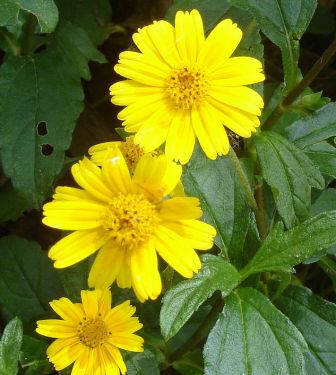
Sphagneticola trilobata - photo by Wedelia
This garden escapee is already a declared Class 3 noxious weed in Queensland and well established in a variety of different environments including riparian areas, drains, roadside, wetlands and rainforest edges. However, in NSW Singapore Daisy has only recently been documented in a drainage area in Wyong Council and most recently in Pittwater, colonising a section of native groundcover in the Bush to Bay reserve, Careel Bay. This first known local incursion is highlighted for control as soon as funding is available to halt spreading.
If you think you have seen Singapore Daisy and certainly before commencing weed control, please contact Council’s Noxious Weed Officer on 9970 1111 to ensure that you have correctly identified this new weed as there are a few similar native daisy plants includingEnhydra fluctuans and Melanthera biflora that may be mistaken for this aggressive weed species.
______________
BANGALLEY HEAD WALK
Saturday 14 May, 9 – 11am
Avalon. Meeting point provided on booking.
Join us for a relaxing morning walk taking in the beautiful views and coastal bushland of Bangalley Head.
Bangalley Head stands as the highest point and one of Pittwater’s largest bushland reserves on its clifftop coastline. This – together with the great variety of native plants and beautiful ocean views – makes Bangalley Head a haven for bushwalkers and wildlife alike. Native birds and marsupials – such as ringtail possums, honeyeaters, spinebills, finches and wrens – feed, breed and shelter among the dense thickets of coastal scrub and pockets of rainforest plants.
This is a fun walk for all the family and a great opportunity to learn more about our amazing flora and fauna!
Bookings essential for all events!
Online - www.pittwater.nsw.gov.au/cecbookings
In person: Coastal Environment Centre, Lake Park Road, North Narrabeen Phone: 1300 000 232
Solar Solutions Workshop- Batteries
May 26th: 7pm to 8pm
Want to know more about solar PV and battery systems? Do you already have a Solar System installed?
Come along to this informative session presented by Pittwater Council in partnership with the Australia Solar Councils Sydney Chapter and hear from a panel of speakers providing an overview on different technologies available and advice.
The session will include a Q&A with the expert panel.
Where: Meeting point provided on booking.
Cost: Free!
Bookings Essential! Online www.pittwater.nsw.gov.au/cecbookings
In person: Coastal Environment Centre, Lake Park Road, North Narrabeen Phone: 1300 000 232
NRMA Pittwater Active Learning Series
Community Planting Day - South Bilgola Headland
May 28th: 8am to 11am
Come and join us for a morning of planting to assist the Council in caring for beautiful South Bilgola Headland.
All tools and equipment will be provided as well as morning tea. An enjoyable event for all the family!
Where: Bilgola Beach Carpark - base of track to southern headland.
Bring: Comfortable shoes or boots, hat, sunscreen and water.
The Sydney Coastal Councils Group and Pittwater Council have committed to this grant program to help restore the Bilgola catchment and bushland. We need your support! For further information please conact the Bushland Management Officer on 9970 1363.
Community Field Day - Upper Mullet Creek
May 29th: 9am to 12pm
Come and join us for a morning of bush regeneration to assist the Pittwater Environmental Foundation and Pittwater Council in caring for Upper Mullet Creek in beautiful Ingleside Chase Reserve.
All tools and equipment will be provided as well as morning tea.
An enjoyable event for all the family!
Where: Ingleside Chase Reserve entrance between 47 & 51 Wesley Street, Ingleside.
Bring: Comfortable shoes or boots, hat, sunscreen, water
The NSW Environmental Trust and Pittwater Council have committed to a six year program to help restore the Mullet Creek area within Ingleside Chase Reserve.
We need your support! For further information please contact the Bushland Management Officer on 9970 1363.
Bookings Online - www.pittwater.nsw.gov.au/cecbookings
In person: Coastal Environment Centre, Lake Park Road, North Narrabeen Phone: 1300 000 232
Ku-ring-gai Chase Indigenous Walk
May 29th, 2016: 9.30am to 11.30am
Come and join A guided bushwalk discovering cultural sites including rock engravings in Ku-ring-gai Chase National Park. This tour led by staff from the Coastal Environment Centre and an Indigenous guide offers a great opportunity to learn more about this amazing area. The walk will give you information on the local flora and their uses as bushtucker and medicines. Look for native animals and their tracks as we explore.
This event is suitable for the whole family!
Where: Meeting point provided on making a booking.
Bookings Essential!
Online - www.pittwater.nsw.gov.au/cecbookings
In person: Coastal Environment Centre, Lake Park Road, North Narrabeen Phone: 1300 000 232
Breakfast with the Birds
June 12th: 7.30am to 9.30am
Wake up to share your morning and breakfast with the birds.
We will take you for a fantastic guided walk to learn more about our feathered friends. Our birding mornings are guided by local experts and are a great opportunity to get a better look at out local bird life.
A great activity for those people interested to learn more as well as passionate birdwatchers.
Where: Deep Creek. Meet point provided on booking.
Bookings Essential!
Online - www.pittwater.nsw.gov.au/cecbookings
In person: Coastal Environment Centre, Lake Park Road, North Narrabeen Phone: 1300 000 232

'Sonic wells' connect Anzac nations with Gallipoli
April 20, 2016: Fran Strachan - UNSW
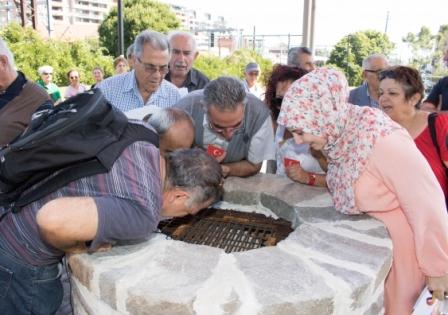
Members of Auburn's Turkish community gather round Sydney's sonic well. Photo: Allan Giddy
Three ‘sonic wells’ connecting Sydney, New Zealand and Turkey aim to reaffirm the bond between the two Anzac nations and their former adversary in the lead-up to Anzac Day.
Sonic Wells for Gallipoli is a tri-national public art installation byUNSW Art & Design academic and internationally renowned artist Allan Giddy.
Each well, built by stone masons, aims to replicate the function of traditional water wells as gathering places for communities.
Located in Auburn, home to Australia's largest Turkish community, Canakkale in Turkey, and Wellington in New Zealand, the wells are linked using customised software similar to Skype, allowing residents in each country to literally speak down the well to each other.
The wells will also transmit ambient sound from city to city: the bustle of Wellington’s Cuba Street Mall; the call-to-prayer from the mosques surrounding Canakkale’s ferry port – the departure point for pilgrims to Gallipoli –and the sounds of Auburn's recently developed Memorial Park, the location of the suburb's war memorial.
“Throughout history the fundamental human need for water has brought people together – around billabongs, streams and wells,” says Giddy from Canakkale, where he is installing the third well and will attend the official opening. “In this work, the three 'sonic wells' will become contemporary gathering places, drawing on both the history and the nature of the well as a meeting place.”
“The installation aims to add a new chapter to the story of three nations who, having developed a mutual respect during the Gallipoli Campaign in World War One, have since forged strong links and continue to build a history together.”
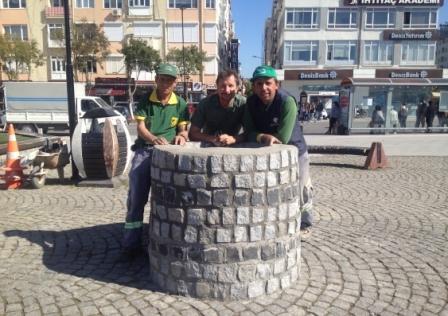
Allan Giddy (centre) with Turkish stone masons after completing the sonic well in Canakkale.
Giddy says Sonic Wells for Gallipoli offers an alternative to the majority of public commemorations and reflections taking place during the WWI centenary years.
“The Turkish diaspora communities in Wellington and Auburn, many of whose relatives participated in WWI, will not only be brought closer to their homeland, but also afforded a voice during the centenary via this inclusive, communicative commemoration,” he says.
Manager of Community Development at Auburn City Council Brooke Endycott said it is a privilege to have a ‘sonic well’ located in Auburn.
“Our local area is home to a rich and highly influential Turkish community and Auburn Memorial Park is a fitting site for the well as it is the location of both the Auburn War Memorial and the Wall of Friendship.”
Sonic Wells for Gallipoli opened simultaneously in all three locations on 23 April, 9am (Turkey), 4pm (Australia) and 6pm (New Zealand).
The project has been awarded significant funding by the Creative New Zealand’s First World War Centenary (WW100) Co-Commissioning Fund, the NSW Government through Arts NSW, and the Australian Government through their Catalyst – Australian Arts and Culture Fund.
Future submarine program
26 April 2016: Prime Minister, Minister for Defence – Joint media release
The Turnbull Government today announces that the next generation of submarines for Australia will be constructed at the Adelaide shipyard, securing thousands of jobs and ensuring the project will play a key part in the transition of our economy.
DCNS of France has been selected as our preferred international partner for the design of the 12 Future Submarines, subject to further discussions on commercial matters.
Along with our recent naval shipbuilding announcements, the commitment to an Australian build will create a sustainable Australian naval shipbuilding industry and provide the certainty that industry requires to invest in innovation and technology and grow its workforce.
The Future Submarine project is the largest and most complex defence acquisition Australia has ever undertaken. It will be a vital part of our Defence capability well into the middle of this century.
This $50 billion investment will directly sustain around 1,100 Australian jobs and a further 1,700 Australian jobs through the supply chain.
Today’s announcement follows the comprehensive Competitive Evaluation Process (CEP) involving DCNS, TKMS of Germany and the Government of Japan. Each bidder submitted very high quality proposals and the Australian Government takes this opportunity to thank both TKMS and the Government of Japan for their ongoing commitment to Australia and their participation in the process.
The CEP has provided the Government with the detailed information required to select DCNS as the most suitable international partner to develop a regionally-superior future submarine to meet our unique national security requirements, as detailed in the 2016 Defence White Paper.
This rigorous and independent process was led by Head of the Future Submarine Program, Rear Admiral Greg Sammut AM CSC, and General Manager Submarines, Rear Admiral Stephen Johnson USN (retired), who was previously in charge of the program to replace the Ohio Class ballistic missile submarines.
The process was overseen by an independent Expert Advisory Panel, chaired by former Secretary of the United States Navy, Professor Donald Winter. It was peer reviewed by Vice Admiral Paul Sullivan USN (retired) and Rear Admiral Thomas Eccles USN (retired).
This decision was driven by DCNS’s ability to best meet all of our unique capability requirements. These included superior sensor performance and stealth characteristics, as well as range and endurance similar to the Collins Class submarine. The Government’s considerations also included cost, schedule, program execution, through-life support and Australian industry involvement.
Subject to discussions on commercial matters, the design of the Future Submarine with DCNS will begin this year.
The Turnbull Government is also conducting a strategic review of the workforce, skills and infrastructure needs to deliver this key capability as part of its Naval Shipbuilding Plan, to be released this year. The Plan will bring together the requirements for the Future Submarine program, along with the more than $35 billion Future Frigate program and the more than $3 billion Offshore Patrol Vessel program, as part of the broader continuous naval shipbuilding philosophy to which the Government is committed.
The Turnbull Government will maximise Australian industry involvement in the program and will work closely with DCNS to identify opportunities for local businesses to integrate into the supply chain.
New online approach to beating illicit drug use in sport
17 April 2016: Media Release - Minister for Sport, the Hon. Sussan Ley
A new free online tool will help guide and support athletes, coaches and sports administrators on the potential consequences of illicit drug use in sport.
Minister for Sport Sussan Ley today announced the release of the Illicit Drugs in Sport (IDIS) e-learning education programme, an interactive multi-media resource developed by the Department of Health’s National Integrity of Sport Unit, in partnership with the Australian Sports Commission.
“Illicit drug use is placing a huge burden on society and the health system, and sport provides a powerful platform to influence a wide cross-section of the community,” Ms Ley said.
“In a sporting context, drug use not only affects the performance of an individual, it also lets down their team, family, and can even affect future sponsorship and career opportunities.
“The IDIS programme is specifically aimed at sub-elite athletes, who are younger and don’t necessarily have access to the same resources elite sportspeople do.
“Sporting bodies have been asking for a resource like this and sporting organisations, particularly at lower levels, don’t often have the resources needed to educate their players.”
The IDIS programme reinforces the Government’s strong commitment to promoting clean competition and keeping Australian athletes free from the influence of illicit drugs and performance enhancing substances.
“The spotlight is firmly on integrity in sport at the moment, so it is extremely important for Australia to maintain a strong stance against the use of performance enhancing substances and illicit drugs in sport,” Ms Ley said.
The National Integrity of Sport Unit and Australian Sports Commission will continue to work closely together to promote illicit drugs prevention efforts with national sporting organisations.
The IDIS e-learning education programme is available on theDepartment of Health website
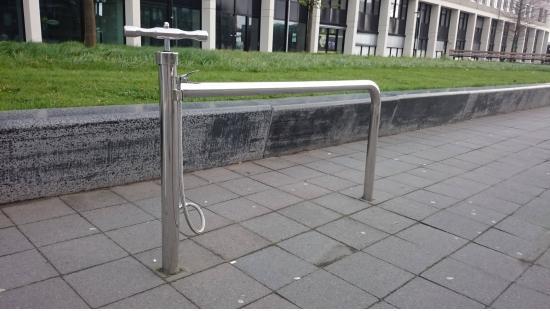
New guidelines for organ transplantation released
11 April 2016: Federal Government Media Release
A record number of Australians benefited from receiving an organ transplant in 2015 with 1,241 Australians receiving a life changing transplant from the generosity of 435 deceased donors and their families.
In an effort to ensure even more Australians lives are saved through organ transplant, the Australian Government today announced the release of new Ethical and Clinical Guidelines for organ transplantation.
The Ethical and Clinical Guidelines, which supersede the Transplantation Society of Australia and New Zealand (TSANZ) Organ Transplantation from Deceased Donors: Consensus Statement on Eligibility Criteria and Allocation Protocols, are the culmination of a collaborative effort by the National Health and Medical Research Council (NHMRC), the Organ and Tissue Authority and TSANZ.
The NHMRC ‘Ethical Guidelines for organ transplantation from deceased donors’ and TSANZ ‘Clinical Guidelines for organ transplantation from deceased donors’, were released at the TSANZ annual scientific meeting in Sydney today.
Assistant Minister for Health and Aged Care Ken Wyatt said the development of the Ethical and Clinical Guidelines highlights the strength of the collaboration between the donation and transplantation sectors.
“Collaboration like this will help us improve donation rates, increasing access to life saving transplants and enable better health outcomes for all Australians,” Minister Wyatt said.
“The guidelines provide an overarching framework for ethical and clinical practice to assist health professionals in assessing complex issues when making decisions regarding organ transplantation.
“They also provide information for potential organ transplant recipients and their families, carers and friends.”
Minister Wyatt said that determining whether a person is eligible to receive a donated organ, in an environment where need outweighs availability, involves balancing ethical issues.
“Given the relative shortage of donor organs, there will always be people who would benefit from an organ transplant but will not be able to receive one. Therefore it is essential that guidelines on organ allocation and transplantation are ethically sound and transparent,” he said.
The Clinical Guidelines provide local and international best practice to guide health professionals when making the complex decisions about organ transplantation.
They address the criteria and processes used to balance the needs of individuals with end-stage organ failure and the obligation of transplant teams to exercise responsible stewardship of the community’s healthcare resources, including donated organs.
In releasing the guidelines, Minister Wyatt paid tribute to all donors and their families who agree to organ donation.
“In 2016 deceased organ donation has continued to break records in Australia with 129 organ donors in January to March this year, compared to 98 over the same period in 2015 (32% growth on 2015),” Minister Wyatt said.
The Ethical Guidelines were developed by the NHMRC’s Australian Health Ethics Committee and inform the TSANZ Clinical Guidelines and will assist health professionals when decisions are needed about entry onto organ transplant waiting lists, donor suitability and organ allocation protocols.
The Clinical Guidelines provide guidance to clinical practice of transplantation in Australia.
The full guidelines are available on the NHMRC website and theTSANZ website.
For more information please visit the Donate Life website.
Glowing nanomaterial to drive new generation of solar cells
April 18, 2016
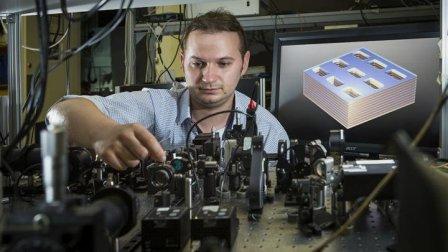
Dr. Kruk is next to a diagram of the metamaterial structure. Credit: Image Stuart Hay, ANU
Physicists have discovered radical new properties in a nanomaterial which opens new possibilities for highly efficient thermophotovoltaic cells, which could one day harvest heat in the dark and turn it into electricity.
The research team from the Australian National University (ARC Centre of Excellence CUDOS) and the University of California Berkeley demonstrated a new artificial material, or metamaterial, that glows in an unusual way when heated.
The findings could drive a revolution in the development of cells which convert radiated heat into electricity, known as thermophotovoltaic cells.
"Thermophotovoltaic cells have the potential to be much more efficient than solar cells," said Dr Sergey Kruk from the ANU Research School of Physics and Engineering.
"Our metamaterial overcomes several obstacles and could help to unlock the potential of thermophotovoltaic cells."
Thermophotovoltaic cells have been predicted to be more than two times more efficient than conventional solar cells. They do not need direct sunlight to generate electricity, and instead can harvest heat from their surroundings in the form of infrared radiation.
They can also be combined with a burner to produce on-demand power or can recycle heat radiated by hot engines.
The research is published in Nature Communications.
The team's metamaterial, made of tiny nanoscopic structures of gold and magnesium fluoride, radiates heat in specific directions. The geometry of the metamaterial can also be tweaked to give off radiation in specific spectral range, in contrast to standard materials that emit their heat in all directions as a broad range of infrared wavelengths. This makes it ideal for use as an emitter paired with a thermophotovoltaic cell.
The project started when Dr Kruk predicted the new metamaterial would have these surprising properties. The ANU team then worked with scientists at the University of California Berkeley, who have unique expertise in manufacturing such materials.
"To fabricate this material the Berkeley team were operating at the cutting edge of technological possibilities," Dr Kruk said.
"The size of individual building block of the metamaterial is so small that we could fit more than twelve thousand of them on the cross-section of a human hair."
The key to the metamaterial's remarkable behaviour is its novel physical property, magnetic hyperbolic dispersion. Dispersion describes the interactions of light with materials and can be visualized as a three-dimensional surface representing how electromagnetic radiation propagates in different directions. For natural materials, such as glass or crystals the dispersion surfaces have simple forms, spherical or ellipsoidal.
The dispersion of the new metamaterial is drastically different and takes hyperbolic form. This arises from the material's remarkably strong interactions with the magnetic component of light.
The efficiency of thermovoltaic cells based on the metamaterial can be further improved if the emitter and the receiver have just a nanoscopic gap between them. In this configuration, radiative heat transfer between them can be more than ten times more efficient than between conventional materials.
Sergey S. Kruk, Zi Jing Wong, Ekaterina Pshenay-Severin, Kevin O'Brien, Dragomir N. Neshev, Yuri S. Kivshar, Xiang Zhang. Magnetic hyperbolic optical metamaterials. Nature Communications, 2016; 7: 11329 DOI:10.1038/ncomms11329
BirdLife Australia's Indigenous Grant for Bird Research and Conservation
BirdLife Australia: April 14, 2016
Indigenous knowledge of native Australian birds, their life cycle, and habitat is profound and has made a substantial contribution to the scientific study of birds in this country.
BirdLife Australia's Indigenous Grant for Bird Research and Conservation wishes to acknowledge this contribution and facilitate further engagement of Indigenous Australians in research and conservation of our native birds.
The 2016 grant is focused on migratory birds and Important Bird and Biodiversity Areas. The grant is funded from the proceeds of print sales from The Flyway Print Exchange.
Check out our website to find out more: http://bit.ly/BirdLifeAwards
Applications close 31 May.
Cheers! Here's to the World's First Gluten-Free Beer
April 15, 2016
Thanks to an Aussie invention, the world's first gluten-free barley beer will appear today in German supermarkets.
CSIRO's Kebari barley has been used to make the world's first commercially produced, full flavoured, barley-based gluten-free beer.
This is especially good news for people with coeliac disease who could soon enjoy a greater variety of foods and beverages thanks to work by Australian scientists.
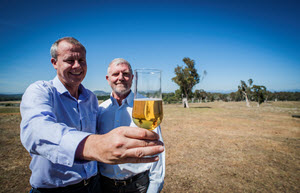 German beer brewing company Radeberger has used Kebari barley to develop the barley based gluten-free beer, Pionier, the first such beer under the German Beer Purity law Reinheitsgebot.
German beer brewing company Radeberger has used Kebari barley to develop the barley based gluten-free beer, Pionier, the first such beer under the German Beer Purity law Reinheitsgebot.
Right: Dr Crispin Howitt and Dr Phil Larkin celebrating the launch of Pionier gluten-free beer, the first product to use CSIRO's Kebari barley.
Scientists from CSIRO, with co-funding from the Grains Research and Development Corporation (GRDC), have bred the Kebari grain, a new barley variety with ultra-low levels of hordeins, the type of gluten found in barley.
"Using conventional breeding we've reduced the gluten levels to 10,000 times less than regular barley which more than meets the World Health Organization's recommendation for calling a grain gluten-free," CSIRO Principal Research Scientist Dr Crispin Howitt said.
In the future, this will provide more variety for the global population, including 1 to 2 per cent of Australians, with coeliac disease and people who avoid gluten in their diet. Diets that restrict grains can be nutritionally poor, high in fat and sugar and low in fibre.
"It's really exciting seeing the first product made with the malted version of our Kebari grain, we hope it's the first of many products," Dr Howitt said.
"We're also working on a hulless version of Kebari which is preferable for use in a range of foods like breakfast cereals, soup, even pasta and flatbreads, which will be the first part of the next generation of gluten-free products helping people with coeliac disease to increase fibre, promote bowel health and enhance nutrition in their diet."
While Pionier beer is only available in Germany, CSIRO is continuing to explore opportunities with Australian brewers to develop a local beer using Kebari barley.
Once development of a hulless version is complete, there is a plan to work with manufacturers to bring a range of foods containing Kebari barley to Australian consumers.
While it is 'ultra-low' in gluten, Kebari grain cannot be called 'gluten-free' in Australia or New Zealand under the current Food Standards Code.
However, the gluten level is well below 20 parts per million, the level recommended by the World Health Organization for classification as gluten-free, so in some other countries, like Germany, products made with Kebari barley can be classified as gluten-free.
The Walter and Eliza Hall Institute of Medical Research and The Royal Melbourne Hospital were involved in the early stages of the ultra-low gluten barley project.
Kebari is a trade mark of CSIRO.

Retford Park Gifted by James Fairfax AC to National Trust Australia (NSW)
April 20, 2016: National Trust Australia (NSW)
The National Trust of Australia NSW has received the largest gift in its 70 year history of conserving the built, cultural and natural heritage of NSW. Philanthropist and arts patron, Mr James Fairfax AC, gifted his historic Retford Park home to the National Trust of Australia along with a significant endowment for the property’s ongoing conservation and maintenance.
Speaking at the handover ceremony at Retford Park yesterday, Mr Fairfax said: “It has long been my wish that Retford Park be preserved so that future generations can see how the property was lived in and used. I know that I am transferring the property into safe hands to be preserved for future generations of Australians.”
Dr Clive Lucas OBE, President of the National Trust, commented: “The National Trust is honoured to receive this gift of the magnificent Retford Park property and the accompanying endowment which together represents the largest gift ever received by the Trust.
Continuous Naval Shipbuilding
18 April 2016: Prime Minister and Minister for Defence – Media Release
The Turnbull Government is securing a sustainable long-term Australian naval shipbuilding industry.
Today the Government is announcing the build locations for 12 Offshore Patrol Vessels and up to 21 Pacific Patrol Boats, in addition to nine Future Frigates previously announced.
These announcements provide for two shipyards to implement the Government’s commitment to a continuous build of naval surface ships in Australia. Major warships will be built in Adelaide and minor vessels in Henderson, Western Australia.
These three projects will ensure Australia retains a sovereign capability to build and sustain its naval vessels. Together they represent close to $40 billion worth of investment in Australia’s future naval capabilities and our naval shipbuilding industry.
They will directly secure more than 2,500 jobs for decades to come. They will also generate thousands of additional jobs with suppliers.
Offshore Patrol Vessels
First pass approval for the Offshore Patrol Vessels, with construction to begin in Adelaide from 2018, following the completion of the Air Warfare Destroyers and transfer to Western Australia when the Future Frigate construction begins in Adelaide in 2020. This approach ensures that jobs and skills are retained in Adelaide.
As part of the Competitive Evaluation Process three designers have been shortlisted; Damen of the Netherlands, Fassmer of Germany, and Lurssen of Germany to refine their designs.
This program is estimated to be worth more than $3 billion and will create over 400 direct jobs.
Future Frigates
First pass approval for the Future Frigates. Three designers – BAE Systems with the Type 26 Frigate; Fincantieri with the FREMM Frigate, and Navantia with a redesigned F100 – have been short-listed to refine their designs. The frigates will all be built in Adelaide, incorporating the Australian-developed CEA Phased-Array Radar.
The Competitive Evaluation Process is on schedule to return second pass approval in 2018, which will allow for construction to commence in Adelaide in 2020.
This program is estimated to be worth more than $35 billion, and will directly create over 2000 jobs.
Pacific Patrol Boats
Combined first and second pass approval for the replacement Pacific Patrol Boats. Austal Ships Pty Ltd has been selected as the preferred tenderer to construct and maintain up to twenty-one replacement steel-hulled Pacific Patrol Boats in Henderson, Western Australia.
Subject to negotiations, this program is estimated to be worth more than $500 million and will directly create over 130 jobs.
Austal proposes to conduct support of the replacement Pacific Patrol Boats including deep maintenance from Cairns, Queensland. In total, through-life support and sustainment (including deep maintenance) for the Pacific Patrol Boats is valued at a further $400 million over the life of the boats.
Today’s announcements are central to the Government’s comprehensive Naval Shipbuilding Plan. These three significant ship builds will deliver the necessary infrastructure requirements across the Adelaide and Henderson shipyards. They will create new jobs, develop necessary skills and broaden cooperation between industry and government.
The Turnbull Government is committed to maximising the opportunities for our Australian Defence industry to participate in these shipbuilding programs. Through the Defence Industry Policy Statement the Turnbull Government will reset the relationship between Defence and industry, driving jobs and innovation which will have spillover effects into the wider economy. In particular, the new Centre for Defence Industry Capability will help small to medium enterprises identify opportunities to join the supply chains necessary to deliver these ambitious naval shipbuilding projects.
The Government’s historic continuous build program will ensure the Navy receives its future capability requirements while delivering the certainty that shipbuilders need.
Secrets of Kokoda Revealed
April 20, 2016: CSIRO
With ANZAC Day approaching, CSIRO in collaboration with the Department of Environment, has announced the delivery of a trove of data on local plants and animals to the people of Papua New Guinea, to help manage conservation and tourism in the area made famous during the Second World War.
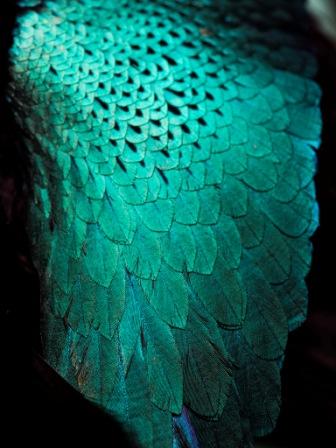
Focusing on the Kokoda Track and Owen Stanley Range, the data is based on specimens collected from the 1950s up until the present day, housed at CSIRO's natural history collections in Canberra.
Over the past three decades, Australia has made spectacular, world leading advances in managing and mobilising its biodiversity data. The Kokoda project represents a huge investment in making PNG's biodiversity available within PNG.
Mr Brendan Lepschi of the Australian National Herbarium said Papua New Guinea was a global hotspot for biodiversity.
"The data we are providing to the people of PNG is a 'snapshot' of biodiversity over time, which can help with understanding what grows and lives where and why, enabling better conservation management, especially given the increased human activity in the Kokoda area," Mr Lepschi said.
Australian National Herbarium staff worked through the collections, making sure specimens were correctly identified, before capturing detailed information, in the Herbarium's electronic specimen database.
"We began with the Ericaceae, a group that includes showy plants such as rhododendrons and is richly represented in the Kokoda area," Mr Lepschi said.
"We then included information on birds, mammals, reptiles and amphibians from CSIRO's Australian National Wildlife Collection, as well as butterflies, dragonflies and beetles from CSIRO's Australian National Insect Collection.
"We'd like to add other plant groups, including ferns, figs and umbrella trees.
"Making PNG collection data available in PNG is vitally important as it can provide decision makers with a sound basis for future work."
Although data from PNG flora and fauna collections are becoming increasingly accessible in Australia, they are not available to researchers in PNG itself. The PNG Conservation and Environment Protection Authority (CEPA) has recently invested considerable resources through the Kokoda Initiative to develop a national biodiversity database, making repatriation of such data possible.
Mr James Sabi of CEPA said the project was very important for PNG.
"It brings together a great deal of biodiversity information from collections all over the world into one place, managed by PNG," Mr Sabi said.
"It's a substantial vote of confidence from the international community that PNG now has the systems and expertise to manage and provide access to this information, and will enable CEPA to make better biodiversity management decisions."
There are special challenges in working with the Herbarium's PNG collection. The flora is less well known than that of Australia, many species are undescribed and specimens are often fragile due to having large, soft leaves that become crisp and brittle when dry.
"Biological collections from 50 or 60 years ago tend to have less label data, including things now considered essential such as latitude and longitude. Identifying exactly where a plant was collected can be difficult due to the complex and changing geography of PNG villages," Mr Lepschi said.
This work was funded by the Australian Department of the Environment to validate and provide biological collection data to the PNG Conservation and Environment Protection Authority for inclusion in the PNG National Biodiversity Information System.
The Australian National Herbarium is part of the Centre for Australian National Biodiversity Research, a joint venture between the Department of the Environment's Parks Australia Division and CSIRO.
Photos: The wing of a Superb Bird of Paradise Lophorina superba which is among some of the specimens collected in PNG by CSIRO. © Martin Ollman
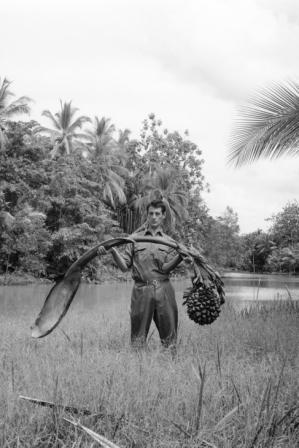
CSIRO botanist Lyn Craven (1945 - 2015) holding a fruiting stalk of a nipa palm (Nypa fruticans), near Ravikivau, Purari River delta, Papua New Guinea, 19 Feb. 1966.© Dick Schodde.
Shakespeare game takes web learning to the next level: Uni. of Sydney Shakespeare Reloaded Website is Open Access - for High School Students and Teachers
Shakespeare game takes web learning to the next level
19 April, 2016: University of Sydney
A new web game for high school students and teachers is turning the cards on traditional approaches to Shakespeare and three of his best known plays.
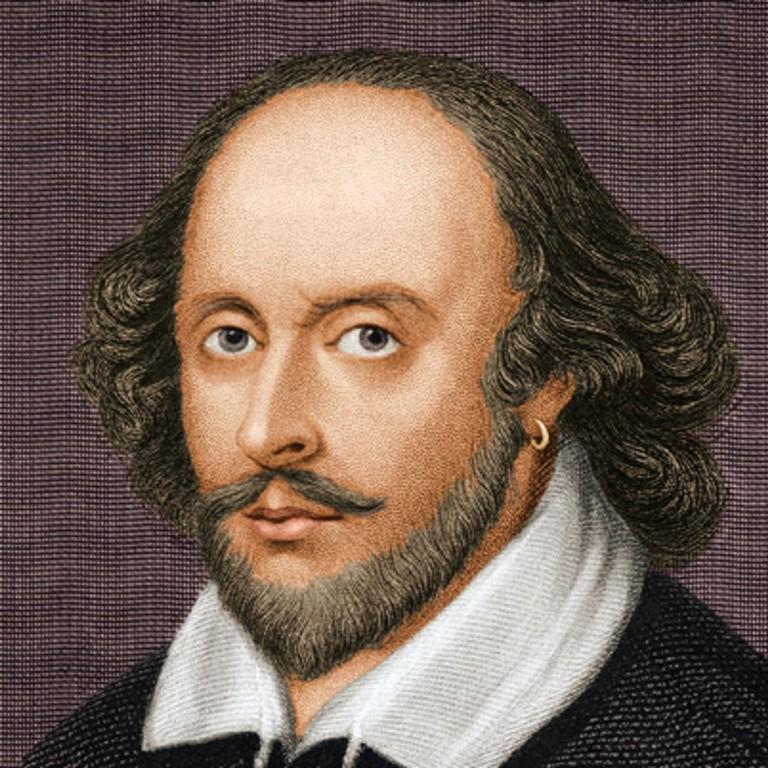
A portrait of William Shakespeare.
Three major Shakespeare plays feature in an innovative online game, developed by the University of Sydney with Barker College.
Four hundred years after Shakespeare’s death, an online game developed by the University of Sydney is using the playwright’s best-known works to challenge traditional approaches to learning and teaching.
Professor Liam Semler of the University’s Department of English leads Shakespeare Reloaded, a project that is urging students and teachers to depart from the curriculum when looking at the British playwright’s work.
‘Shakeserendipity’ launches as global events explore and celebrate the Bard’s legacy. Where the game stands out is through its clever use of Shakespeare as a gateway to other learning. For example, Richard III’s numerous animal references and Julius Caesar’s espionage themes lead teachers and students to resources about biology and surveillance.
“Four centuries after Shakespeare’s death, we have to explore new ways of engaging with his work and using the genius of his plays in creative teaching approaches,” said Professor Semler.
“Shakespeare was an innovator in his time, so it’s fitting that a project like ours is using digital innovation to challenge and disrupt traditional ways of learning. We know there are ideas in Shakespeare that are timeless and can be used as a doorway to other learning — our new game encourages and enables these experiments,” he said.
The game allows players, be they teachers or students, to select two to four online cards from a deck of nine associated with an individual play by Shakespeare. Currently, three decks are available: The Tempest, Richard III and Julius Caesar.
‘Wild’ and ‘tame’ cards in each deck involve different levels of difficulty, and the ability to shuffle cards means teachers can create a range of possible educational scenarios that integrate online, in-class and out-of-class learning.
Barker College in Hornsby collaborates with the University on the Shakespeare Reloaded project, and hosted the pilot version of the game.
“The Shakeserendipity pilot provided some great approaches to teaching, by throwing out ideas to students to research and bounce off each other,” said Lucy Solomon, a Stage 6 English teacher at Barker College. “It’s exciting to take a text that is 400 years old and present it to students through lenses which appear totally out of the box.”
The Shakespeare Reloaded website and its resources are open access and based on the latest research into education conducted at the University of Sydney.
"The beauty of Shakeserendipity is that it takes the old 'flipped classroom' idea to a new level in which standard outcomes are done away with and student learning is imagined in the same dimension as teachers’ professional development," said Professor Semler.
Shakeserendipity and the research that was used to build it will be showcased at the British Shakespeare Association’s conference at the University of Hull, England, in September.
Shakeserendipity: www.shakespearereloaded.edu.au/activities/shakeserendipity
Shakespeare Reloaded website: www.shakespearereloaded.edu.au
Call Out For Next Generation of YouTube Talent – Screen Australia and Google Help Filmakers Skip Ahead – Pool of $750,000 Available
MEDIA RELEASE: Monday 18 April 2016
Screen Australia and Google are back with the third instalment of Skip Ahead, the program that helps new generations of online storytellers expand their vision and the scale of the content they create on YouTube. With past Skip Ahead alumnae including Aunty Donna (103,489 subscribers • 12,202,848 views), SketchShe (763,971 subscribers • 85,634,620 views), Mighty Car Mods (1,816,456 subscribers • 244,207,055 views) and Axis of Awesome(288,469 subscribers • 46,005,519 views), the program is also a step in building sustainable screen careers.
The program will provide project funding of up to $250,000 each for three successful Australian YouTube content creators who have existing YouTube channels with a substantial subscriber base. The funding is for successful applicants to make a longer narrative-driven film of at least 30 minutes in length, which may be a one-off film, or could act as a pilot for a series or proof of concept for a feature, provided it can be viewed as a standalone piece of entertainment.
Skip Ahead encourages any genre of narrative film, but it should play to the applicants’ strengths and their audience’s expectation, and represent a clear step in terms of storytelling ambition and production values.
The project will be expected to premiere on the filmmakers’ YouTube Channel, but they will be able to explore other releases such as theatrical event screenings and top tier film festivals. As part of its support for Skip Ahead, Google and Screen Australia may also facilitate networking opportunities between creators and Australian production companies interested in skills exchange or creative collaboration.
Mike Cowap from Screen Australia said: “This is an extraordinary program for YouTubers to make the leap from short form to longer content. We are constantly blown away by what YouTubers achieve with very little resources. This is a great opportunity for our local content creators to get the extra support they may need to take their work to the next level. ”
“Skip Ahead fosters the next generation of Australian storytellers by providing funding, education and support for the production of new online content. The first two rounds of Skip Ahead winners created fantastic online series and we hope this third wave of funding for long-form content will help budding Australian filmmakers reach global audiences on YouTube.” said Kristen Bowen, Head of Top Creators — APAC, YouTube Australia.
Previous recipients of Skip Ahead funding are eligible to apply.
For further information about Skip Ahead, including assessment and eligibility criteria, please click here.
Applications close on 20 May 2016. Successful applicants will be announced in June 2016.
Junior Lifesavers of The Year Announced
Thursday 14 April 2016: SLS NSW
Two young lifesavers have capped off their Nipper careers in grand style by taking out the Junior Lifesaver of the Year Award (JLOTY) in Sydney on Thursday.
Byron Vinkovic (Shellharbour SLSC) and Ella Cook (Narrabeen Beach SLSC) impressed the judging panel during this week’s development program at the Collaroy Learning Centre.
They were among 22 Under 14 finalists from the 11 branches in NSW nominated to take part in the annual leadership and development program which brings together like-minded young lifesavers in their final year of Nippers.
“It feels amazing and I was shocked and excited when I heard my name. It’s great to win this award as sometimes our branch isn’t recognised as much as the others so to win something this big is amazing – nothing compares to it,” a clearly delighted Byron Vinkovic said.
Like many of his peers, the young South Coast lifesaver was introduced to the beach early in life, and once he entered the water for the first time as an U8 Nipper he was hooked.
Throughout the JLOTY program the young lifesavers participated in a variety of workshops as well as recreational activities all designed to develop the leadership potential of the lifesavers and highlight the many opportunities in Surf Life Saving.
“I’ve learned so many new leadership skills and ways of thinking. I learned a lot about self-reflection and thinking about how I could be a better person, especially through the resilience workshops and talks by previous Junior Lifesavers of the Year,” Byron said.
Ella Cook has been involved in Nippers since she was very young and believes this week’s program has been one of the highlights of her years in surf life saving.
“It was really good how quickly the friendships developed and I think that was because we are all like-minded and share a similar interest. In fact on the second day people were already saying that it felt like they had known each other for years,” said Ella.
“I can honestly say the whole experience was amazing and I got so much out of it. I’ve met some new lifelong friends and have learned so much which I can now take back to my club where all the youth members can benefit from this knowledge,” she said.
The experience of the JLOTY Program reinforced both Byron’s and Ella’s ambitions to stay involved with their clubs.
“I really want to get my Bronze and Silver Medallions and become a Patrol Captain. The other thing I would love to do at some stage is become an IRB Crewman as it’s something I’ve always wanted to do, and my long-term goal is to go to university and get a degree in some form of medicine,” said Byron.
Ella also wants to take advantage of the range of opportunities offered in surf life saving.
“I really want to get my Bronze Medallion which I can do next season and go from there. I would love to become an IRB Crewman and gain qualifications in spinal management and all the other skill areas as well.
“Eventually I would like to be on the club Board of Management as well as try to implement a program that myself and the other Sydney Northern Beaches Branch representative developed during JLOTY,” Cook added.
Both Byron and Ella will be honoured as part of the annual Awards of Excellence to be held in Sydney in August.
2015/16 SLSNSW Junior Lifesaver of the Year Branch Finalists
Jorja Williams - Helensburgh - Stanwell Park SLSC (Illawarra)
Keehan Reilly- Helensburgh - Stanwell Park SLSC (Illawarra)
Grace Kuhnell - Wauchope Bonny Hills SLSC (Mid North Coast)
Isaac Plunkett - Port Macquarie SLSC (Mid North Coast)
Annabelle Smith - Broulee Surfers SLSC (Far South Coast)
Jake Shaw - Pambula SLSC (Far South Coast)
Chloe Walker - Coogee SLSC (Sydney)
Michael De Francesco – North Cronulla SLSC (Sydney)
Poppy Smyth – Coffs Harbour SLSC (North Coast)
Patrick de Carle – Sawtell SLSC (North Coast)
Ella Cook (Narrabeen Beach SLSC) (Sydney Northern Beaches)
Zizo Ayoub – Dee Why SLSC (Sydney Northern Beaches)
Annelise Romer – Forster SLSC (Lower North Coast)
Jordan Fowler – Forster SLSC (Lower North Coast)
Jade Williams – Cooks Hill SLSC (Hunter)
Luke Walmsley – Caves Beach SLSC (Hunter)
Cerys Cousins – MacMasters Beach SLSC (Central Coast)
Dylan Barrett – Ocean Beach SLSC (Central Coast)
Jessica O’Donnell – Nowra-Culburra SLSC (South Coast)
Byron Vinkovic – Shellharbour SLSC (South Coast)
Hayley Smith – Cudgen Headland SLSC (Far North Coast)
Zane Patience - Cabarita Beach SLSC (Far North Coast)
Outdoor light has role in reducing short-sightedness in kids
April 6, 2016L QUT
Increasing exposure to outdoor light is the key to reducing the myopia (short-sightedness) epidemic in children, according to ground-breaking research by Australian optometrists.
Optometrist and lead researcher on the project, Associate Professor Scott Read who is the director of research at QUT's School of Optometry and Vision Science, said children need to spend more than an hour and preferably at least two hours a day outside to help prevent myopia from developing and progressing.
Speaking at the Australian Vision Convention in Queensland on the weekend, Professor Read said it was not 'near work' on computer and other screens causing myopia, but a lack of adequate outdoor light.
"While screens are contributing to children spending more time indoors than in previous years, the research shows they are not the direct cause of the increased incidence of myopia," he said.
"Optometrists need to make their patients aware that less than 60 minutes' exposure to light outdoors per day is a risk factor for myopia.
"It looks like even for those with myopia already, increasing time outside is likely to reduce progression."
Optometry Australia president Kate Gifford said "this new finding is of significant importance in our endeavour to mitigate the growing rate of myopia in children."
In February, it was announced that half the world's population will be short-sighted by 2050 with many at risk of blindness.
The global study, published by the Brien Holden Vision Institute, forecasts that 10 per cent of the world's population will be at risk of blindness by 2050 if steps are not taken to stop myopia turning into high myopia (requiring glasses with a prescription of minus five or stronger).
The QUT study measured children's eye growth via study participants wearing wristwatch light sensors to record light exposure and physical activity for a fortnight during warmer then colder months to give an overall measurement of their typical light exposure.
"Children exposed to the least outdoor light had faster eye growth and hence faster myopia progression," Professor Read said.
The above is reprinted from materials provided by Queensland University of Technology.
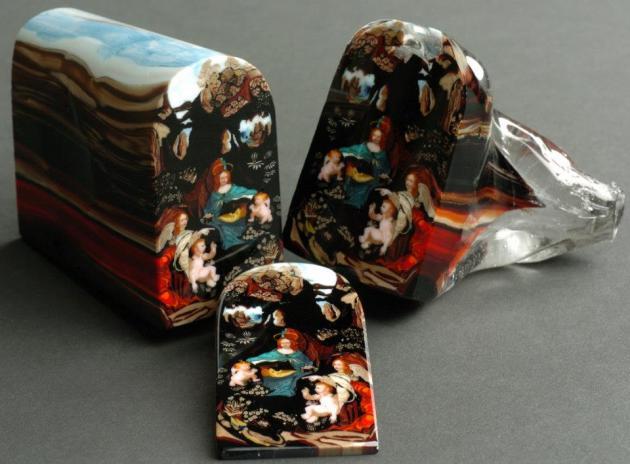
Madonna of the Rocks Murrine
Murrina (common pluralization murrine) is an Italian term for colored patterns or images made in a glass cane (long rods of glass) that are revealed when cut in cross-sections. Murrine can be made in infinite designs—some styles are more familiar, such as millefiori. Artists working in glass design murrine in a variety of ways from simple circular or square patterns to complex detailed designs to even portraits of people. Murrine are designed by layering different colors of molten glass around a core, then heating and stretching it into a rod. When cool, the rod is sliced into cross-sections of desired thickness with each slice possessing the same pattern in cross-section.
The murrina process first appeared in the Middle East more than 4,000 years ago and was revived by Venetian glassmakers on Murano in the early 16th century.
Madonna of the Rocks: SOLD OUT
(2 1/4" x 1 3/16") The most elaborate murrini to date involving hundreds of component parts, fully shaded detail throughout. Artist Loren Stump’s signature is in the Madonna's brooch.
This work is one of several by Artist Loren Stump
Visit: www.stumpchuck.com
Disclaimer: These articles are not intended to provide medical advice, diagnosis or treatment. Views expressed here do not necessarily reflect those of Pittwater Online News or its staff.